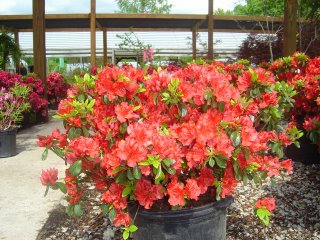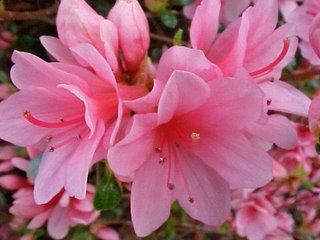THE OLD SIGN PHILOSOPHER, THOUGHT FOR THE DAY!
I EXERCISE..............BY PUSHING MY LUCK
Saturday, March 18, 2006
Thursday, March 16, 2006
GREENSCAPE GARDENS TOP 2006 PERENNIAL PICKS
1. Hemerocallis 'Stella de Oro'
2. Hemerocallis 'Happy Returns'
3. Coreopsis v. 'Moonbeam'
4. Hosta 'Francee'
5. Artemisia s. 'Silver Mound'
6. Gaillardia 'Fanfare' PP15892
7. Salvia n. 'May Night'
8. Hosta 'Sum and Substance'
9. Sedum 'Autumn Joy'
10. Perovskia atriplicifolia
11. Hemerocallis 'Stella de Oro'
12. Hemerocallis 'Happy Returns'
13. Coreopsis v. 'Moonbeam'
14. Hosta 'Francee'
15. Artemisia s. 'Silver Mound'
16. Gaillardia 'Fanfare' PP15892
17. Salvia n. 'May Night'
18. Hosta 'Sum and Substance'
19. Sedum 'Autumn Joy'
20. Perovskia atriplicifolia
We have over 20,000 Greenscape Grown Perennials growing in our five greenhouses.
1. Hemerocallis 'Stella de Oro'
2. Hemerocallis 'Happy Returns'
3. Coreopsis v. 'Moonbeam'
4. Hosta 'Francee'
5. Artemisia s. 'Silver Mound'
6. Gaillardia 'Fanfare' PP15892
7. Salvia n. 'May Night'
8. Hosta 'Sum and Substance'
9. Sedum 'Autumn Joy'
10. Perovskia atriplicifolia
11. Hemerocallis 'Stella de Oro'
12. Hemerocallis 'Happy Returns'
13. Coreopsis v. 'Moonbeam'
14. Hosta 'Francee'
15. Artemisia s. 'Silver Mound'
16. Gaillardia 'Fanfare' PP15892
17. Salvia n. 'May Night'
18. Hosta 'Sum and Substance'
19. Sedum 'Autumn Joy'
20. Perovskia atriplicifolia
We have over 20,000 Greenscape Grown Perennials growing in our five greenhouses.
IMPROVE THE SOIL FOR MAXIMUM RESULTS
A healthy, flourishing garden begins with healthy soil. By learning as much as you can about your soil, you will be better able to match plants to your conditions. Missouri Botantical Gardens, University of Missouri Extension Service and even OK Hatchery in Kirkwood can test your soil. The test will reveal the composition of your soil (whether it’s predominantly clay, loam or sand), the nutrient levels in your soil, and the soil’s pH (its acidity or alkalinity).
You can also do a home test to determine whether your soil is clay, loam or sand. Put a handful of garden soil in a litre jar, fill it with water, shake, and then leave it to settle for a day. Sand will settle to the bottom, silt will be the next layer, with clay on top. (Organic matter will float on the water’s surface.) Compare the percentage of each layer to determine whether you’ve got loam (20% clay, 40% silt, 40% sand), clay (60% clay, 30% silt, 10% sand), or sand (5% clay, 10% silt, 85% sand).
A laboratory soil test will tell you whether your soil’s pH is acidic, neutral or alkaline--which will help you determine what plants will do best in your conditions.
To determine the drainage capacity of your soil, dig a hole 1 foot deep and 1 foot wide. Fill it with water, let it drain completely, then fill again until the soil is saturated. Depending on how long it takes for this last batch to drain, you’ve either got adequate drainage (less than 2 hours), or poor drainage (more than 2 hours).
Whatever your soil type, pH, drainage and nutrient levels, you can improve the health of your soil by adding compost. Dig in lots of compost when first preparing your garden bed for planting. In already established gardens, add a 3-inch layer of compost around your plants in spring, summer or fall.
Additional information about improving your soil can be found at our website.
Great gardens ONLY happen when an improved soil foundation has been installed. At Greenscape Gardens we are constantly informing the customer to spend additional monies on improving the soil and less on the plant material. We are in the business to sell plants but plants only grow and prosper when they are given the proper incentives to grow........GOOD SOIL.
A healthy, flourishing garden begins with healthy soil. By learning as much as you can about your soil, you will be better able to match plants to your conditions. Missouri Botantical Gardens, University of Missouri Extension Service and even OK Hatchery in Kirkwood can test your soil. The test will reveal the composition of your soil (whether it’s predominantly clay, loam or sand), the nutrient levels in your soil, and the soil’s pH (its acidity or alkalinity).
You can also do a home test to determine whether your soil is clay, loam or sand. Put a handful of garden soil in a litre jar, fill it with water, shake, and then leave it to settle for a day. Sand will settle to the bottom, silt will be the next layer, with clay on top. (Organic matter will float on the water’s surface.) Compare the percentage of each layer to determine whether you’ve got loam (20% clay, 40% silt, 40% sand), clay (60% clay, 30% silt, 10% sand), or sand (5% clay, 10% silt, 85% sand).
A laboratory soil test will tell you whether your soil’s pH is acidic, neutral or alkaline--which will help you determine what plants will do best in your conditions.
To determine the drainage capacity of your soil, dig a hole 1 foot deep and 1 foot wide. Fill it with water, let it drain completely, then fill again until the soil is saturated. Depending on how long it takes for this last batch to drain, you’ve either got adequate drainage (less than 2 hours), or poor drainage (more than 2 hours).
Whatever your soil type, pH, drainage and nutrient levels, you can improve the health of your soil by adding compost. Dig in lots of compost when first preparing your garden bed for planting. In already established gardens, add a 3-inch layer of compost around your plants in spring, summer or fall.
Additional information about improving your soil can be found at our website.
Great gardens ONLY happen when an improved soil foundation has been installed. At Greenscape Gardens we are constantly informing the customer to spend additional monies on improving the soil and less on the plant material. We are in the business to sell plants but plants only grow and prosper when they are given the proper incentives to grow........GOOD SOIL.
Tuesday, March 14, 2006
 ONE OF THE MOST BEAUTIFUL FLOWERING SHRUBS IN NATURE IS DEFINITELY THE AZALEA. FOR THE LARGEST SELECTION OF AZALEAS IN THE MIDWEST, GREENSCAPE GARDENS. THE SHADEHOUSE IS BRIMMING WITH 10 DIFFERENT VARIETIES OF AZALEAS. PLUS A GREAT SELECTION OF RHODIES.
ONE OF THE MOST BEAUTIFUL FLOWERING SHRUBS IN NATURE IS DEFINITELY THE AZALEA. FOR THE LARGEST SELECTION OF AZALEAS IN THE MIDWEST, GREENSCAPE GARDENS. THE SHADEHOUSE IS BRIMMING WITH 10 DIFFERENT VARIETIES OF AZALEAS. PLUS A GREAT SELECTION OF RHODIES. BUY THEM NOW..........
WOULDN'T YOU PREFER THE FLOWERS IN YOUR GARDEN THAN GREENSCAPE GARDENS.

WELCOME WILDLIFE TO THE GARDEN
With spring quickly approaching, we should consider welcoming wildlife into our gardens. Birds, butterflies and pollinating insects all bring life to the garden and pleasure to the gardener. Hang out the welcome mat by creating habitat that meets the needs of wild creatures.
The best way to attract wildlife is to plant a diversity of species: trees, shrubs and perennials. These different layers in the garden will provide a variety of habitats for the specific needs of various creatures.
Include varieties of flowers that bloom throughout the growing season, from spring to fall, ensuring a long-lasting food source for nectar-loving creatures such as butterflies. Leave seedpods on perennial plants over the winter to provide an important food source for birds. If you have the space, consider planting both deciduous and evergreen trees, which will provide year-round habitat for birds. Choose shrubs that produce berries for birds.
Consider replacing a portion of the lawn with either a flowerbed or a low-growing groundcover. Lawns provide little in the way of wildlife habitat.
Consider adding a water feature to your garden. This is one of the best ways to create wildlife habitat. Water features can be as simple as a bowl of water left on the ground in an open area or, better yet, it can be a bird bath. A pond requires more work (both in planning and in maintenance), but has enormous wildlife benefits.
To attract wildlife, it’s important to garden organically. Synthetic chemicals kill butterflies and beneficial insects. Keep a list of the creatures that visit your garden habitat, and share the news of sightings with others in your neighbourhood. It may inspire them to create wildlife habitat, too.
With spring quickly approaching, we should consider welcoming wildlife into our gardens. Birds, butterflies and pollinating insects all bring life to the garden and pleasure to the gardener. Hang out the welcome mat by creating habitat that meets the needs of wild creatures.
The best way to attract wildlife is to plant a diversity of species: trees, shrubs and perennials. These different layers in the garden will provide a variety of habitats for the specific needs of various creatures.
Include varieties of flowers that bloom throughout the growing season, from spring to fall, ensuring a long-lasting food source for nectar-loving creatures such as butterflies. Leave seedpods on perennial plants over the winter to provide an important food source for birds. If you have the space, consider planting both deciduous and evergreen trees, which will provide year-round habitat for birds. Choose shrubs that produce berries for birds.
Consider replacing a portion of the lawn with either a flowerbed or a low-growing groundcover. Lawns provide little in the way of wildlife habitat.
Consider adding a water feature to your garden. This is one of the best ways to create wildlife habitat. Water features can be as simple as a bowl of water left on the ground in an open area or, better yet, it can be a bird bath. A pond requires more work (both in planning and in maintenance), but has enormous wildlife benefits.
To attract wildlife, it’s important to garden organically. Synthetic chemicals kill butterflies and beneficial insects. Keep a list of the creatures that visit your garden habitat, and share the news of sightings with others in your neighbourhood. It may inspire them to create wildlife habitat, too.
Subscribe to:
Comments (Atom)





